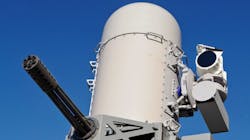Raytheon to provide electro-optical targeting kits for cruise missile defense aboard surface warships
WASHINGTON – Electro-optical targeting system experts at the Raytheon Co. will provide the U.S. Navy with MK 15 Close-In Weapon System (CIWS) sensor kits under terms of a $13.6 million order announced last week.
Officials of the Naval Sea Systems Command in Washington are exercising options for the Raytheon Missile Systems CIWS sensor kits for shipboard cruise missile defense.
The CIWS uses an integrated stabilized electro-optical sensor to guide a variety of weapons to their targets in the terminal missile defense role aboard Navy surface ships and shore systems.
CIWS is a fast-reaction terminal defense against low- and high-flying, high-speed maneuvering anti-ship missiles that have penetrated all other defenses, Navy officials say.
The CIWS is an integral element of the Fleet Defense In-Depth concept and the Ship Self-Defense Program. Operating either autonomously or integrated with a surface warship combat system, it is an automatic terminal defense weapon system designed to detect, track, engage, and destroy anti-ship missile threats penetrating outer fleet defenses.
CIWS consists of three variants: Phalanx, which uses a six barrel Gatling gun; land-based Phalanx Weapon System (LPWS), and SeaRAM, which replaces the gun with an 11-round Rolling Airframe Missile (RAM) guide.
CIWS is installed on Navy and Coast Guard ships and is also in use in foreign navies. The Phalanx Block 1B CIWS weapon systems also are being installed on low-boy trailers with self-contained diesel electric power and cooling water.
This configuration of the Phalanx CIWS is the Mk 15 mod 29 Land-based Phalanx Weapon System (LPWS) and has been deployed to Iraq to help protect deployed U.S. and allied forces from threats like incoming rockets, artillery shells, mortars, and unmanned aerial vehicles (UAVs).
The Phalanx electro-optical stabilization system (EOSS) from the L3Harris Technologies Inc. Brashear segment in Pittsburgh combines rugged, high-precision electro-optical instrumentation with the flexibility to serve on a variety of vessels and weapon platforms.
The Phalanx EOSS was designed to withstand continuous gun shock in a naval environment. The high-performance isolation and decoupling system enables tracking during gun firing, and its lightweight pedestal minimizes impact on gun servo performance.
The Phalanx EOSS is available as part of an integrated fire-control system or as a component for OEM applications. The upper and lower mounting points accommodate a variety of electro-optic sensors such as forward-looking infrared (FLIR) sensors, visible-light cameras, and lasers.
On this order Raytheon will do the work in El Segundo, Calif., and should be finished by December 2022. For more information contact Raytheon Missile Systems online at www.raytheon.com, or Naval Sea Systems Command at www.navsea.navy.mil.
About the Author
John Keller
Editor-in-Chief
John Keller is the Editor-in-Chief, Military & Aerospace Electronics Magazine--provides extensive coverage and analysis of enabling electronics and optoelectronic technologies in military, space and commercial aviation applications. John has been a member of the Military & Aerospace Electronics staff since 1989 and chief editor since 1995.
